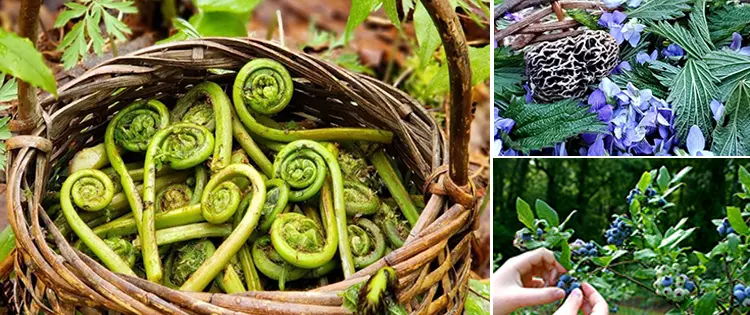Our ancestors were foragers, they knew nothing about processed foods. But as history progressed, processing became a lot more convenient. Recently, an increasing number of people are revisiting the eating habits of our ancestors, and foraging is back in style. Eating from the ground gives you control over the foods you eat, provides numerous health benefits, and deepens your connection to nature. Here is a list of wild edibles you should forage this fall.
Elderberries
You can use elderberries to make pies, crumbles, liqueurs, and jams. It is important to mention that when eaten raw, some elderberries can be toxic, and they are also very tart in taste. Therefore, it is advised that they are cooked before eating them.
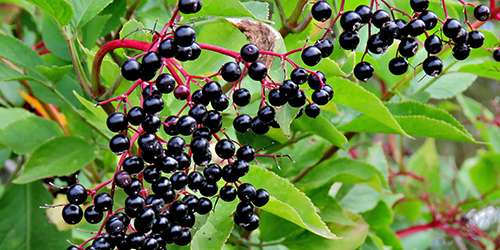
How to Identify Elderberries
Elderberries grow on woody trees or shrubs. They don’t have individual leaves, they grow in multiples of 5-11 arranged opposite each other on an axis. They are generally serrated and long.
Poisonous Look-Alike
The Aralia Spinosa (also known as the devil’s walking stick), is the elderberries poisonous look-alike. They grow in the same dense cluster of dark purple berries. The main difference between elderberries and Aralia Spinosa is the thorns or spines that grow out of their branches. Elderberries do not have this feature.
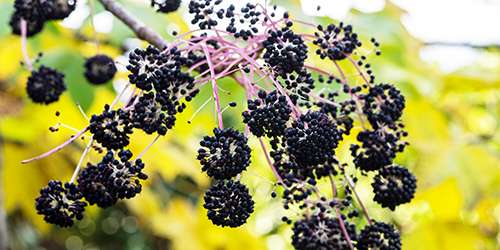
Natural Remedy
Elderberry is a popular medicinal plant and a powerful remedy for rheumatism and fever. Ancient Egyptians used it to heal burns and improve their complexions. Today, it is most commonly used to treat flu and cold symptoms.
Wild Grapes
Wild grapes are not the type of grapes you’ll find in the store. They look similar, and they grow in clusters. Wild grapes also have a very strong grape flavor. You can eat wild grapes or juice them; they are high in vitamin C, K, potassium, and copper. Wild grapes contain around 100 calories per cup, depending on the sugar content.
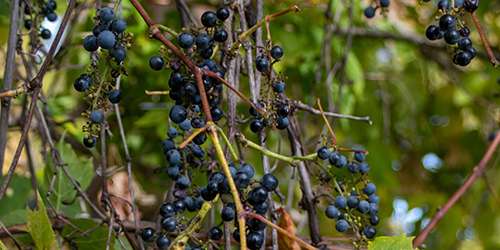
How to Identify Wild Grapes
As long as it has a support structure, the grapevine can grow to 100 feet in height. Their leaves have a very distinctive growth pattern, they grow on both sides of the stem, and they are between 2 to 5 inches in length.
Poisonous Look-Alike
Common moonseed is a wild grape look-alike. The difference between the two is the moonseed contains one flat seed, and wild grapes have 1-4 pear-shaped seeds.
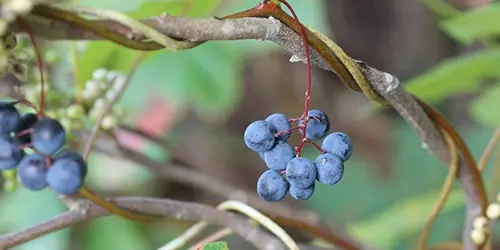
Natural Remedy
Grapes are high in antioxidants, they prevent chronic illnesses such as heart disease, cancer, and diabetes. They are also high in fiber and contain a lot of water which reduces the risk of constipation, and helps keep bowel movements regular. Additionally, grapes contain quercetin which has an anti-inflammatory effect and provides relief from allergy symptoms such as hives, watery eyes, and runny nose.
Wild Persimmon
This fruit has been described as a wrinkled, gooey mess. They are extremely sweet and look like small oranges. It’s advised that you only eat wild persimmon when it’s all the way ripe or you’ll be in for an unpleasant surprise because the taste is really sour. One-piece contains 127 calories, and one cup of pulp provides the daily requirement of vitamin C. You can either turn them into jam, fermented wine, or you can eat them raw.
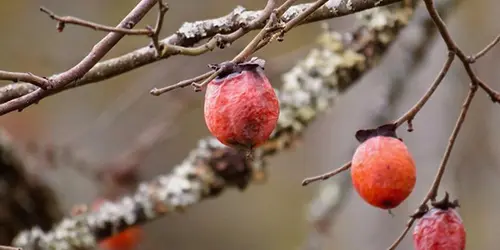
How to Identify a Wild Persimmon Tree
The tree is between 40 to 70 feet tall; the leaves should have foliage that is 2 to 3 inches in width, and 4 to 6 inches in height. However, the upper half of the leaves are a dark green glossy color, and they are oblong in shape. Also, the edges of the leaves are smooth, they look like leather, and the tips are pointed.
Poisonous Look-Alike
Wild persimmon does not have a poisonous look-alike.
Natural Remedy
Persimmon leaves contain antioxidants such as carotenoids, tannins, triterpenoids, and flavonoids, which help fight inflammation and hypertension. They are also good for purifying the liver.
Plantain
The plantain plant is also known as ‘Plantago’, the leaves and seeds can be eaten, or you can use them for their many medicinal purposes. Plantain leaves are extremely nutritious, they are full of vitamins and minerals such as vitamins A, C, and K. They are also a rich source of magnesium, calcium, and iron.
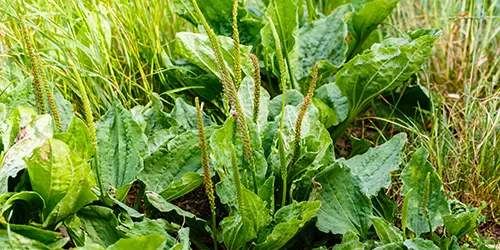
How to Identify Plantain
Plantain grows very low on the ground, its leaves are very distinctive, featuring prominent parallel veins. The leaves overlap and grow at the base of the plant forming a shape similar to a rose.
Poisonous Look-Alike
Plantain has a few look-alikes, but none of them are poisonous. One such plant is hostas, they are also called plantain lilies.
Natural Remedies
Plantain is a powerful medicinal plant, the leaves can be applied to the skin to heal rashes, scrapes, and bites.
Wild Tomatoes
Botanists call them Solanum pimpinellifolium, they are the original tomatoes. Every other tomato came from them, and they still grow in the wild today. They are very small and don’t grow larger than a shelled pea.
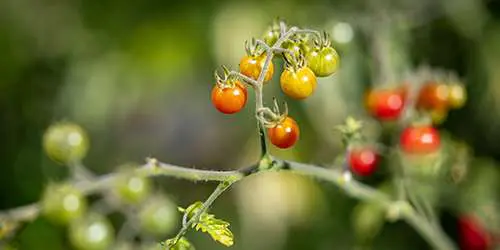
How to Identify a Wild Tomato Plant
When the tomatoes haven’t started growing, the plant is difficult to identify. However, the leaves are the main characteristic of a wild tomato plant. Their regular leaves are around 10 inches long, the smaller leaves are about three inches long. The leaves have a slight fuzziness when touched, they are also serrated and pointed.
Poisonous Look-Alike
To the uneducated forager, horse nettle appears to be the perfect juicy snack. With its yellow or greenish color, and its tomato-like appearance, this wild nightshade relative can be extremely harmful to humans.
Natural Remedy
Wild tomatoes are rich in potassium which helps to lower blood pressure. They also contain antioxidants that protect the body against chronic illnesses such as heart disease and cancer. Wild tomatoes are also a powerful source of vitamin C which strengthens the immune system.
Wild BlackBerries
Wild blackberries are also known as brambles because their growth pattern is thorny and tangled. Tart but sweet, wild blackberries are a summer staple and food for both humans and animals. They are packed with vitamin C and K, they are also high in fiber and manganese.
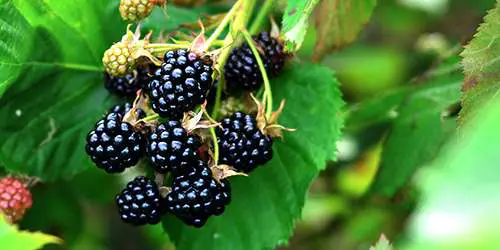
How to Identify Wild BlackBerries
Wild blackberries produce flowers before they turn into fruits. They start off as a small collection of green drupelets, but as they begin to ripen and grow, wild blackberries transition through several colors before they turn black, including red, pale pink, white and green.
Poisonous Look-Alike
The pokeweed plant grows the most appetizing-looking and juiciest berries during the late summer and early fall. But these berries are not for human consumption, eating as little as a handful can kill. Pokeweed is easy to spot, they grow in grape-like clusters, they are a very dark purple in color. Their stalks can grow to up to 8 feet tall, they are a cross between purple and pink.
Natural Remedy
Blackberries are known to prevent scurvy, heal wounds, and boost brain health.
Final Thought
As exciting as foraging is, if you don’t know what you’re doing, it can be dangerous. Do plenty of research to ensure you don’t pick poisonous look-alikes. Some edibles look very appetizing, smell, touch, and fully inspect the edible before bringing it into your home.
You may also like:
9 Best Plants That Naturally Repel Pests from Your Homestead
Easy to Build Root Cellar in Your Own Backyard (Video)
Why You Should Raise Ducks Instead Of Chickens

